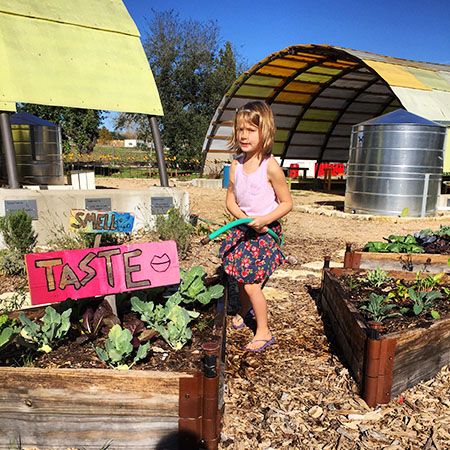Experiential learning is learning through the reflection of doing. Some of the many great things about school and home gardens are the endless possibilities of learning through doing. The Sustainable Food Center (SFC) Teaching Garden hosts hundreds of children a year through school field trips, summer camps, and volunteer work days. Community gardeners and neighbors also visit the garden to play, explore, and learn about food production. The experience they get at SFC’s Teaching Garden is very different from a classroom setting. They get dirty and sweaty (or very cold!); they smell the aroma of herbs; and they taste flavors from plants like strawberries, arugula, and chives. They see (and smell) food and plant scraps composting and turning back into soil. In a garden, the entire life cycle of a plant can be explored. Not only are environmental sciences available to explore in a garden, so too are art, writing, and math. One of our favorite garden activities is to find, collect and sort plant parts, counting how many categories we have and discussing the role of each part. It’s simple but fun, active, and tactile. Pull out a microscope to explore all of the plant parts, and a whole new world is opened up. Having an art or writing period in a garden will invoke feeling and inspiration in students. Teachers can introduce great painters like Claude Monet and Georgia O’Keeffe and ask students to create their own masterpiece with inspiration from the garden.
In a garden, children also learn about the resources necessary to grow their own food, such as water. The connection between food production and the water cycle is effectively demonstrated by having a child help water seedlings. At the SFC Teaching Garden, we have recently installed a simple rainwater collection system which demonstrates a direct correlation to the water cycle, weather patterns, and water conservation. And when a butterfly, bee or insect is spotted in the garden, an opportunity to discuss pollinator importance in food production is presented. In April, the SFC Teaching Garden will welcome honeybees into a newly built apiary. Children will be able to safely view bees in their hives as well as pollinating plants throughout the garden.
Another benefit of a garden is that there is greater connection to food when children see it growing and then harvest and eat it. A child that refuses to eat a green vegetable may feel more adventurous when she picks it from the garden herself. Children can take part in cooking too. A pizza garden is a great way to bridge gardening and cooking. To make a pizza garden, create a circle-shaped garden bed with a 4’ radius. Divide the circle into six pie-shaped wedges. In each wedge plant oregano, basil, parsley, chives, tomatoes and peppers. These will be the ingredients for your pizza. After the produce has ripened, prepare for a pizza party. Make or buy pizza dough – kids love rolling it out – and using the tomatoes and herbs, make a pizza sauce. Top with bell peppers, cheese and anything else you’d like.
There are many experiential learning opportunities in a garden. The SFC Grow Local School Garden Activity Guide has more ideas for easy educational activities that can be done in a school or home garden, and it can be purchased here.
If you would like to schedule a field trip to the SFC Teaching Garden for a hands-on learning experience for children PreK-12th grade, you may do so here.

